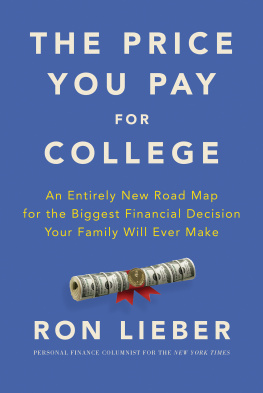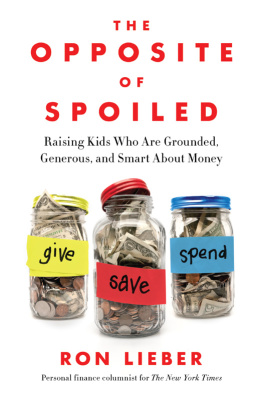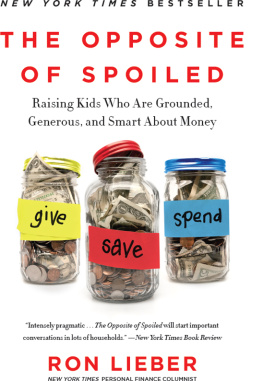Ron Lieber - The Price You Pay for College
Here you can read online Ron Lieber - The Price You Pay for College full text of the book (entire story) in english for free. Download pdf and epub, get meaning, cover and reviews about this ebook. year: 2021, publisher: Harper, genre: Politics. Description of the work, (preface) as well as reviews are available. Best literature library LitArk.com created for fans of good reading and offers a wide selection of genres:
Romance novel
Science fiction
Adventure
Detective
Science
History
Home and family
Prose
Art
Politics
Computer
Non-fiction
Religion
Business
Children
Humor
Choose a favorite category and find really read worthwhile books. Enjoy immersion in the world of imagination, feel the emotions of the characters or learn something new for yourself, make an fascinating discovery.
- Book:The Price You Pay for College
- Author:
- Publisher:Harper
- Genre:
- Year:2021
- Rating:5 / 5
- Favourites:Add to favourites
- Your mark:
- 100
- 1
- 2
- 3
- 4
- 5
The Price You Pay for College: summary, description and annotation
We offer to read an annotation, description, summary or preface (depends on what the author of the book "The Price You Pay for College" wrote himself). If you haven't found the necessary information about the book — write in the comments, we will try to find it.
Ron Lieber: author's other books
Who wrote The Price You Pay for College? Find out the surname, the name of the author of the book and a list of all author's works by series.
The Price You Pay for College — read online for free the complete book (whole text) full work
Below is the text of the book, divided by pages. System saving the place of the last page read, allows you to conveniently read the book "The Price You Pay for College" online for free, without having to search again every time where you left off. Put a bookmark, and you can go to the page where you finished reading at any time.
Font size:
Interval:
Bookmark:
To Violet, who is worth every penny...
Not long ago, just a handful of years before a frightening virus caused nearly everyone to question almost everything, we reached a startling threshold in the financial life of American families that went mostly unnoticed: All of a sudden, sending an eighteen-year-old away to a state university for four years cost over $100,000 in many parts of the country. Many families of first-year students who head off to any of several dozen of the most selective private colleges these days will spend over $300,000 before they graduate. So not only is the price of college often a six-figure expense per child, the difference in price between public and private colleges is itself a six-figure number.
Multiply these figures by two or three kids, all of whom may be a decade or more away from matriculating, and an overall picture comes into focus: For many families, the total bill for college could well add up to more than what they paid for their homes. Add in the potential impact of those four years on the trajectory of any adolescents lifeand the fact that so many of our own hopes and dreams for our children are mixed up in the college choiceand the magnitude of the decision looms even larger. This is the most complex and emotionally fraught financial decision that many families will ever make.
The numbers are staggering, and they have reached these heights at the same time that other fast-growing personal finance line items have come into sharper focus. Retirement is now mostly the responsibility of workers, not employers. The out-of-pocket costs of health insurance continue to rise for families who earn more than average. Housing prices in many urban and suburban markets, especially the ones with good public schools, are near all-time highs. And in places where the cost of living is more reasonable, salaries tend to be lower, which makes saving for higher education that much harder.
Perhaps you set a goal on the day of the positive pregnancy test or adoption notice to pay that $300,000 private college bill in full. Saving that much from the day that child was born would have meant putting away $1,000 per month. For those of us with two or more kids (mine are now fifteen and five), saving at that level is akin to making another mortgage payment. The large number of people who have saved somethingbut could not save the full $300,000 over twenty years or somight turn to loans with up to a thirty-year repayment period to help pay the resulting tuition bills. They could end up spending a combined fifty years paying for college. Thats longer than most people spend in the workforce and twenty years longer than most people spend paying off a mortgage.
The prospect of a half century of saving and paying is troubling enough, but the most daunting part of the process is this: There is often no way to know what youll actually pay until the very end of a tumultuous application process. Only after acceptances are out do the schools offer unpublished discounts and negotiate with families who file appeals, one by one, over the final bill. It all happens in secret. And if youve qualified for need-based financial aid, the aid application process generally begins anew each year of college for every student who has already matriculated.
Getting to the final, cumulative price tag requires a long journey, and the maps available to guide families are pretty crude. To even try to navigate it all requires an understanding of the way in which the definition of financial aid has become warped beyond all measure in less than a generation. The primary definition is the one that most of us know from when we were in college: You apply for aid, and if the federal government and your college determine that your family doesnt earn or have enough to pay full freight, you might get some scholarships and grants. Loans and perhaps a work-study job fill out the rest of that financial aid package.
But in the last two decades or so, another form of assistance has grown so quickly as to confuse things entirely. It is called merit aid, although using aid in this context is misleading. Merit scholarships are actually, more often than not, a discounting system whereby colleges below the overall top thirty to forty or so in the U.S. News & World Report rankings slash prices in individually targeted offer letters in the hope of persuading students to enroll. This has nothing to do with financial need, just to be crystal clear. But the private collegesand many of the public universities charging inflated prices to out-of-state studentsknow all too well that a $40,000 or $50,000 price gap per year between the cost to attend their institutions and the flagship state universities (in the applicants home states) that they compete with will be too much for many families to bear. So at the end of the process, they cut the price for many students, especially good ones. Some of them come from the 1 percent.
This raises some obvious questions about equity, for what merit aid really does is aid the family that may be able to afford the sticker price but isnt sure that its willing to pay $200,000 more for Oberlin or Connecticut College over the in-state rates at the University of Virginia or Michigan or Washington. Whereas the old-fashioned system of need-based aid exists to help families who have less, merit aid is as much about psychographics as it is about demographics. Flattery is part of the goal: A child has been judged meritorious enough to get the award! Wouldnt it be foolish to turn it down?
This should not, in fact, be a rhetorical question, and some parents do spend many months during their childs junior and senior years of high school wrestling with possible answers. Perhaps thats you, and youve already started ingesting anecdotal information in frantic late-night gulps through ad hoc online grapevines as anonymous commenters on College Confidential and its ilk toss around out-of-context numbers. Locally, fellow parents who went through the process last year will pontificate with Great Authority (but much less accuracy) about how or why this or that family could have gotten a scholarship, given its supposedly flush financial situation.
Most college counselors and outside consultants, stretched just to define the right academic fit for each student and work over the ever-worsening admissions odds at many schools, cant possibly keep up with all of the various schools financial machinations. Yet theyre who anxious parents turn to (or turn on) when, come April, supposedly undeserving seniors get huge merit aid awards that other students never even knew about. The parents of the students who receive no merit aidand there are manywonder if theyre suckers for signing up anywhere at full price. Meanwhile, befuddled families that include younger high school students hear vague rumors about this process and look to colleges own websites for information about merit aid. When they do, they often find little or nothing that provides much clarity.
Now imagine youre a parent who does not speak English. Or you didnt go to college yourself. Or youre seventeen years old and, for one reason or another, youre navigating the system all by yourself in a high school that has one guidance counselor for every 430 students. (Thats the average ratio in public schools nationwide, by the way.) Good luck sorting it all out in time to pick the schools where you have the best chance of getting the most financial help.
But this is only the half of it. Once you do figure out what you might have to pay, you have to make a decision about value. Economists are fond of declaring Game over on this front, given what we know about how much more college graduates earn on average than people who never attend college or drop out. So many families have already decided that college is mission critical, and once you confront the price you might have to pay, you then have to try to assign a value to each school. What is the degree from any particular college worth? When is the extra $50,000 or $100,000 or $150,000 or $200,000 for one school versus another worth it? What is the return on investment going to be? And how on earth is anyone supposed to figure it all out?
Font size:
Interval:
Bookmark:
Similar books «The Price You Pay for College»
Look at similar books to The Price You Pay for College. We have selected literature similar in name and meaning in the hope of providing readers with more options to find new, interesting, not yet read works.
Discussion, reviews of the book The Price You Pay for College and just readers' own opinions. Leave your comments, write what you think about the work, its meaning or the main characters. Specify what exactly you liked and what you didn't like, and why you think so.








